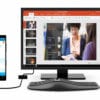Installing programs and games, downloading songs and movies, creating documents and other files – all of these will require space on your desktop computer. You may not be concerned about your machine’s storage space while it is still new, but eventually, you will run out of megabytes to spare. Either you delete your old files, or you expand your computer’s capacity. If you decide to do the latter, then adding an internal hard drive is a great option.
Benefits of an Internal Hard Drive
What exactly is an internal hard drive and why get one instead of purchasing an external hard drive? The former will need to be installed inside your computer’s CPU or tower, while the latter only requires a cable or wireless connection to be accessible from your PC.
At first glance, a USB or wireless external drive may be the most convenient choice. However, if you constantly connect and disconnect it from your computer, cable degradation is bound to happen. Also, by their nature, external drives are more portable. Carrying them around without proper care, however, will lead to the drive’s early retirement.
So, if portability is not an issue, an internal hard drive is the better choice. Sure, it might need installation, but that is a one-time thing. Afterward, it is there in your CPU, usable anytime you want. Plus, since it is protected by the computer tower case, it won’t easily be degraded or corrupted.
Internal hard drives can be used to store all kinds of files, including images, videos, and documents. Since most machines sold on the market today are typically single-drive, this means you will be installing all of your programs in one storage unit, along with your video and image files. Now, imagine there was an operating system failure that corrupted the whole drive. Most likely, you will lose all of those cherished files you’ve collected over the years.
If you add an additional internal hard drive, however, you can install all applications on the primary drive, and then collate all of your movies, pictures, favorite songs, and personal documents in the secondary storage unit. This gives you an extra layer of protection from a malfunctioning OS or from data corruption brought on by viruses and malware.
Overall, internal hard drives are a great choice for expanding your desktop computer’s storage capabilities. Buying the right one for your needs will take a bit of consideration, though, but this guide will clarify what factors you need to review.
Choosing the Right Internal Hard Drive Type – HDD or SSD
When shopping for an internal storage device, you will be confronted with two main types: a mechanical hard drive (also known as a hard disk drive or HDD) and a solid-state drive (also called SSD). Find out which one is the most ideal for you.
Mechanical Hard Drive
HDDs have one or more rotating platters to handle the writing and overwriting of data. They are considered the traditional means of internally storing data on your computer. This 60-year-old technology has come a long way since its first introduction by IBM in 1956.
Although a little bit slower than their modern counterparts, hard disk drives are still considered highly reliable devices. The best part is that they are way cheaper. So if budget is a concern, and you don’t mind the extra few seconds of processing, then HDDs are your best bet.
For a great choice, check out the 1 Terabyte WD Blue SATA HDD. It is an excellent product that only costs $50!
Solid-State Drives
SSDs use flash memory technology to process stored information. This means they are faster at reading and writing data, without using too much power. They also last longer and because they are designed to have no moving parts (no rotating platters), then expect them to run smoothly and noiselessly.
On the flip side, the higher the storage capacity, the more expensive they get. But if you have the cash to spare, go for an SSD. The Samsung 850 EVO is an excellent option in this category. It offers 500 GB of space for a little bit over $150.
Performance Considerations
Once you’ve figured out which type to buy, it is time to look at other important factors for purchasing the best internal hard drive for your needs.
Capacity – How Much Space is Available?
If you are buying an internal hard drive, might as well go for the option with the largest available space that you can afford. Mainstream options offer 500 GB of storage space, but if you have a bit of extra cash, 1 or more Terabyte drives are advisable. If budget is tight, though, there are 250 GB options that can tide you over.
Know that if you want to play a lot of games or if you are an avid movie watcher or music file connoisseur, then you will really need a lot of space. Again, a 1TB or more option suits you best.
Form Factor – How Big is It?
Form factor is a phrase used to describe the size of the hard drive. For most desktop computers, 3.5-inch HDDs will do just fine. If you see 2.5 or 1.0-inch options, they are for laptops and for smaller consumer electronics respectively.
Note though that SSDs are typically designed to be smaller. Often, you will find 2.5-inch solid-state drives. If you go down this route, you are likely to need an adapter to fit the drive into your CPU’s 3.5-inch connector.
Revolutions per Minute (RPM)
If you decided to purchase an HDD, you have to look into your options’ RPM. This refers to the rotating platters and how fast they spin. The higher the number means the faster the spinning. If you want something that can read and write data faster, you would want a high-RPM HDD, around 7,200 RPM.
You need not be concerned about this factor if you mean to buy a solid-state drive.
Cache Space Affects Transfer Speed
Another important matter to look at when buying an internal hard drive is “cache space” or “buffer”. This refers to the temporary memory space the hard drive will use when transferring data from one section to another. If there is more cache space available, data transfer can be done faster. Choices range from 8MB to 128MB.
Connection Interface
How the hard drive is connected to your computer will impact how well it performs. So first, let’s take a look at ATA, one of the interface standards you are likely to come across. This refers to Advanced Technology Attachment. This is a standard connection interface, which can also be referred to as PATA, IDE, or EIDE.
Another industry standard is SATA or Serial ATA, which utilizes serial signaling technology to store your data. SATA hard drives are improved versions of ATA HDs and will perform better. Both ATA and SATA are great choices for personal computers, with the latter being more high-end and a little bit costlier.
If you are planning to buy extra hard drives for enterprise use, however, it is advisable to go for those with SCSI and SAS connection interface. These are better at compartmentalizing processes, making them enhanced multitaskers. They are ideal high-performance drives for dynamic business information storage needs.
The Sweet Spot
We recommend that you combine an SSD and HDD when you are adding more internal hard drives. Go for a solid-state drive with low storage capacity, such as the 80GB Intel Mainstream SATA II. You can install all of your programs and games there, and this will result into faster computer boot-up and speedier game processing.
You can then install a 1 TB or more HDD where you can store all of your music and video files. Collect years of entertainment media and rest assured that they will be there for you to access whenever you please.


